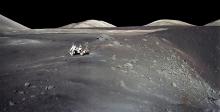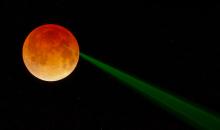Listen to today's episode of StarDate on the web the same day it airs in high-quality streaming audio without any extra ads or announcements. Choose a $8 one-month pass, or listen every day for a year for just $30.
You are here
More Moon and Mars
The Moon and Mars drop down the western sky this evening. They’re high in the sky at nightfall, with Mars to the lower right of the Moon. They set by 1 or 2 in the morning.
The Sun lights up only about a quarter of the lunar hemisphere that faces our way, but you can still make out some of the Moon’s dark features. They formed when giant asteroids or comets slammed into the Moon. The impacts blasted out wide, shallow basins that filled with molten rock.
Samples from the Apollo missions have suggested the bombardment was especially heavy about four billion years ago — about a half billion years after the birth of the planets.
By then, there shouldn’t have been many big asteroids or comets still around. But the giant outer planets may have been changing positions, moving toward the Sun, then back out again. That could have stirred up any leftovers, sending them toward the inner planets. If so, then not just the Moon got smacked; so did Earth, Mercury, Venus, and Mars.
The idea of a late bombardment has faced some challenges. Some researchers have suggested that many of the Apollo samples came from the formation of just one large basin, not many. In that case, the volcanic rocks from the Apollo missions should be the same age.
The issue won’t be settled until new missions bring back more samples from all across the Moon — telling us whether the worlds of the inner solar system took a heavy pounding four billion years ago.





